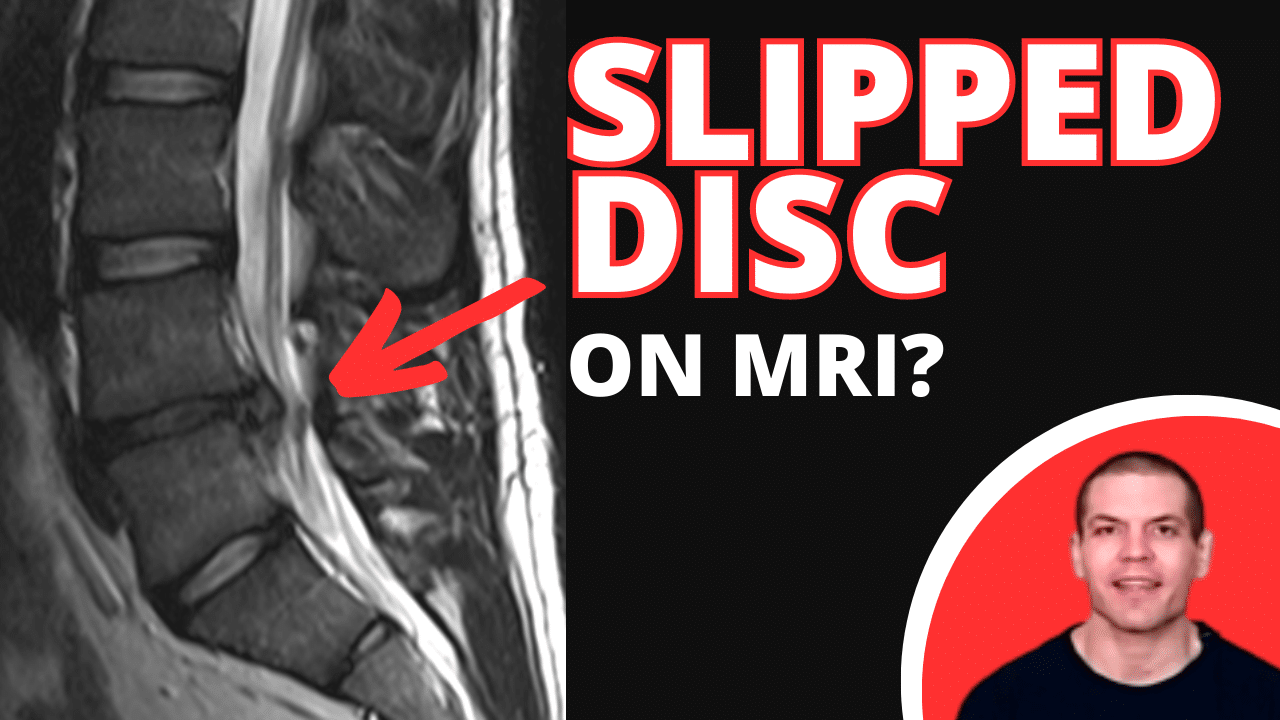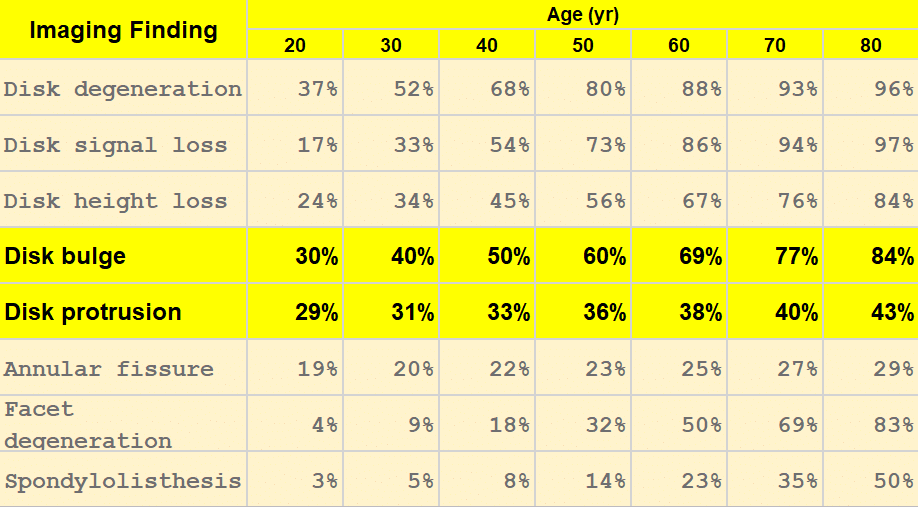You Can See A Slipped Disc On An MRI
If you've been diagnosed with a slipped disc on your MRI, you be worried about how serious it is. Watch the video to learn the 4 stages of herniated discs, how to tell if it's serious, and what you can do to get relieve back pain even if you have a slipped disc on your MRI.

What Is A Slipped Disc?
A "slipped disc" is a common name for a herniated disc.
QuickNote: "Slipped disc" isn't really a correct medical term.
But a lot of people still ask about a "slipped disc", so I'm going to use that term in this post.
The discs in your spine lay between the vertebrae (back bones).
They're often described as a "jelly donut" with a soft inside and a hard outside.
What do your discs do?
Your discs help hold your vertebrae together and give your spine stability. They also make your spine and resistant to compression forces.
What does a slipped disc look like on an MRI?
Discs don't really "slip" in and out of place per se.
However, what people typically refer to as a "slipped disc" is when the nucleus pulposis of the disc (the "jelly" of the donuts so to speak), starts to push through the the hard outer part of the disc (the annulus fibrosis).
That process is referred to as a bulge or herniation depending on the stage. However, there are actually 4 different stages of a herniated disc.
What Are The 4 Stages Of A Slipped Disc?
The 4 stages of a slipped disc are:
- Bulge - the nuclear material starts to push out against the annulus
- Protrusion - a focal part of the discs starts to protrude into the annulus
- Extrusion - the protrusion goes all the way through the
- Sequestration - a piece of the herniation breaks off.
What Are The Symptoms Of A Slipped Disc?
The symptoms of a slipped disc depend on the stage it's in.
When the disc is just bulging, the most common symptom is just back pain.
Usually if the pain is disc-related, the pain will be centrally in the spine without radiation into the legs.
A you start getting out into that extrusion phase of a herniated disc, then disc may start to put pressure on your nerve roots.
That in turn can cause symptoms that go down into your leg. That may be:
- pain
- numbness
- tingling
- weakness
In very, very serious cases, it can be loss of bowel or bladder function. For example, you may either have trouble going or you can't hold it.
How Serious Is A Slipped Disc?
If you're having bowel bladder problems, that's more of a serious medical issue.
In the case of weakness, if you notice that you're starting to get weaker over time, that's also a little more serious.
For example, maybe you didn't have any weakness and then it came on.
Or you had just a little bit of weakness and over time it's worse.
However, if you just have back and/or leg pain then that's not quite as serious of a problem.
What Should I Do If I Have A Slipped Disc On My MRI?
Now there are lots of studies that show abnormal MRI findings in "normal" individuals.
For example, check out the results from this study in American Journal of Neuroradiology about MRI findings in people without any spine pain.
As you can see, bulging, herniated, and degenerative discs are fairly common in people without any pain.
What that means is that even if you have a bulging disc or herniated disc on your MRI, you may not necessarily need surgery.
In fact, the herniated disc might not even be the cause of your pain.
You very well have had a bulging or herniated disc before your pain started.
Then when you start having pain and a doctor finds a slipped disc on your MRI, there's the natural assumption that your pain "MUST" be caused by the disc problem.
However, if you remember from statistics class way back when:
Correlation does not imply causation
It's possible that your pain can be caused by something else, for example, joint problems or muscle problems. And that you just happed to also have a herniated disc.
And so just because you see a slipped disc on your MRI doesn't necessarily mean that it's necessarily the cause of your pain.
So that begs the question...
What's The Best Treatment For a Herniated Disc?
Well, that really depends on the clinical presentation.
As clinicians, we don't treat the findings of the MRI.
We treat the patient that comes with the MRI.
At least that's the way we do it here at More 4 Life.
We believe in treating you like a whole person, not just a chart number and an MRI.
So the best treatment for a slipped disc really depends on the problems that it's causing you.
For example, whether your pain is when you're standing, sitting, laying down, that's going to direct the be the appropriate treatment for your particular problem more so that the findings of an MRI.
Can a chiropractor fix a slipped disc?
Chiropractic treatment or spinal manipulation is a really good treatment for some types of back pain.
In fact, there's good evidence that spinal manipulation is very effective for certain types of people with back pain, particularly people with more recent onset of back pain (<16 days ago) that don't have pain that goes down your leg.
(Interestingly, that study was done by physical therapists, not chiropractors)
Now if you do have pain that goes down your leg past the knee, spinal manipulation may not necessarily be the best treatment for you.
Now as to whether a chiropractor can "fix" a slipped disc per se, again like I can't emphasize this enough:
Your spine is very strong. Your discs don't tend to slip out of place and slip back into place.
So while spinal manipulation can be very helpful, just know that the cause of that manipulation being helpful has more to do with the nerves and the input of that manipulation delivers to your nerves. Spinal manipulation can relieve pain and relax muscles spasms.
However, a chiropractor can't "fix" a slipped disc by manipulating it "back into place."
In fact, if anything, spinal manipulation is more likely to make a disc bulge more rather than less.
What Are Some Other Treatments For A Slipped Disc?
Only in rare cases (less than 5%) do slipped discs need surgery.
In the rest of the case, conservative treatment is very helpful for slipped discs.
That's something that we help people with here at More 4 Life.
We help people to stay active, mobile, and healthy without relying on pain medications, injections, or surgeries.
We DO use spinal manipulation for certain people who are most likely to benefit from it.
However, in other cases, we just help you get back to doing the things that bother you most.
Whether that's:
- getting a good night's sleep
- being able to go out for a walk
- getting back to your exercise routine
- being able to spend time with your kids or grandkids
Whatever things are important to you, we help get you back to those things so can get more enjoyment from your life.
If you'd like help for back pain from a slipped disc and would like to be more active without needing surgery, then tap the button below to request an appointment.
Like this post? You may enjoy these posts too:





